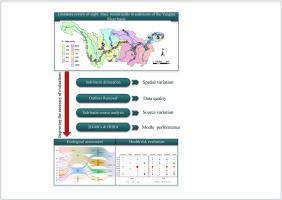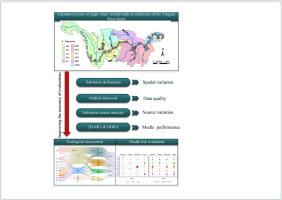长江流域沉积物中痕量金属(loid)s的源导向精确风险评价
IF 7.3
2区 环境科学与生态学
Q1 ENVIRONMENTAL SCIENCES
引用次数: 0
摘要
河流沉积物中的微量金属(TMs)对水生生态系统和人类健康构成重大威胁,风险来源在大流域表现出明显的空间异质性。精确识别优先控制tm和高风险区域对于有效的流域规模管理至关重要。本研究结合2000-2020年的公开数据,采用正矩阵分解(PMF)方法对长江流域不同污染源的生态风险和人类健康风险进行了综合评价。结果表明:各子流域Cd累积超过区域背景水平的平均因子为19.62,其中人为活动(工业、农业和采矿)对总TMs的贡献超过60%,洞庭湖和鄱阳湖的贡献超过80%。生态风险评价结果显示,24.8%的流域为中高风险区,其中工业污染源占38.1%。而人类健康风险仍低于安全阈值(致癌和非致癌风险均为1%)。值得注意的是,农业来源的砷主导了整个流域的非致癌风险,工业/天然铬和砷分别驱动了大多数子流域的致癌风险。DTH子盆地综合风险最高,需要特别严格的暴露控制(非致癌性≤47天/年,儿童致癌性风险≤122天/年)。本研究细化了面向源的评价结果,建立了具体的暴露参数阈值。研究结果为长江流域重金属污染的防治措施和精准治理提供了科学依据。本文章由计算机程序翻译,如有差异,请以英文原文为准。


A source-oriented precise risk assessment of trace metal(loid)s in sediments of the Yangtze River Basin
Trace metal(loid)s (TMs) in river sediments pose significant threats to aquatic ecosystems and human health, with risk sources exhibiting substantial spatial heterogeneity across large basins. Precise identification of priority TMs for control and high-risk regions is critical for effective basin-scale management. This study integrated Positive Matrix Factorization (PMF) source apportionment with publicly available data (2000–2020) to assess source-specific ecological and human health risks in the Yangtze River sub-basins. The results demonstrated that Cd accumulation exceeded regional background levels by an average factor of 19.62 across all sub-basins, with anthropogenic activities (industrial, agricultural, and mining) contributing over 60 % of total TMs, especially exceeding 80 % in Dongtinghu (DTH) and Poyanghu (PYH). Ecological risk assessments revealed that 24.8 % of the basin exhibited moderate-to-high risk, with industrial sources alone accounting for 38.1 %. However, human health risks remained below safety thresholds (<1 % for both carcinogenic and non-carcinogenic risks). Markedly, agricultural-derived As dominated non-carcinogenic risk basin-wide, while industrial and natural sources, along with the elements Cr and As, respectively drove carcinogenic risk in most sub-basins. The DTH sub-basin, which exhibited the highest combined risks, required particularly stringent exposure controls (≤47 days/year for non-carcinogenic and ≤122 days/year for carcinogenic risks in children). This study refines the source-oriented assessment results and establishes specific exposure parameter thresholds. The result provides a scientific basis for preventive measures and precision management of heavy metal pollution in the Yangtze River Basin.
求助全文
通过发布文献求助,成功后即可免费获取论文全文。
去求助
来源期刊

Environmental Pollution
环境科学-环境科学
CiteScore
16.00
自引率
6.70%
发文量
2082
审稿时长
2.9 months
期刊介绍:
Environmental Pollution is an international peer-reviewed journal that publishes high-quality research papers and review articles covering all aspects of environmental pollution and its impacts on ecosystems and human health.
Subject areas include, but are not limited to:
• Sources and occurrences of pollutants that are clearly defined and measured in environmental compartments, food and food-related items, and human bodies;
• Interlinks between contaminant exposure and biological, ecological, and human health effects, including those of climate change;
• Contaminants of emerging concerns (including but not limited to antibiotic resistant microorganisms or genes, microplastics/nanoplastics, electronic wastes, light, and noise) and/or their biological, ecological, or human health effects;
• Laboratory and field studies on the remediation/mitigation of environmental pollution via new techniques and with clear links to biological, ecological, or human health effects;
• Modeling of pollution processes, patterns, or trends that is of clear environmental and/or human health interest;
• New techniques that measure and examine environmental occurrences, transport, behavior, and effects of pollutants within the environment or the laboratory, provided that they can be clearly used to address problems within regional or global environmental compartments.
 求助内容:
求助内容: 应助结果提醒方式:
应助结果提醒方式:


